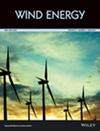考虑弯曲叶尖形状的水平轴风力涡轮机叶片空气动力学模型的比较
IF 3.3
3区 工程技术
Q3 ENERGY & FUELS
引用次数: 1
摘要
弯曲叶尖延伸是转子创新概念之一,有助于提高水平轴风力涡轮机的性能和降低成本。利用其优势的关键驱动因素之一是在设计阶段使用准确高效的计算空气动力学模型。本工作概述了不同最先进模型的性能。采用了以下工具,按复杂性降序排列:(i)叶片解析的Navier-Stokes求解器,(ii)升力线模型,(iii)基于涡流的近尾流模型与远尾流模型耦合方法,以及(iv)广泛使用的叶片单元动量法(BEM)的两种实现方式,有径向感应和无径向感应。当模拟参考风力涡轮机的基线几何形状和具有相对较大的后掠角和/或二面角的不同叶尖延伸设计时,对代码的预测进行了比较。选择了四种载荷情况进行比较,以涵盖空气动力学建模的几个方面:稳定功率曲线、俯仰阶跃、极端运行阵风冲击和深失速静止。本研究强调了基于边界元法的公式在捕捉尖端曲率引入带来的趋势方面的局限性。即使在使用径向感应子模型时也是如此。其余的计算方法在大多数研究的载荷情况下显示出相对良好的一致性。静止配置是一个例外,因为叶片解析的Navier-Stokes解算器是唯一能够捕捉深度失速的高度不稳定影响的代码。本文章由计算机程序翻译,如有差异,请以英文原文为准。
Comparison of aerodynamic models for horizontal axis wind turbine blades accounting for curved tip shapes
Curved tip extensions are among the rotor innovation concepts that can contribute to the higher performance and lower cost of horizontal axis wind turbines. One of the key drivers to exploit their advantages is the use of accurate and efficient computational aerodynamic models during the design stage. The present work gives an overview of the performance of different state-of-the-art models. The following tools were employed, in descending order of complexity: (i) a blade-resolved Navier Stokes solver, (ii) a lifting line model, (iii) a vortex-based method coupling a near-wake model with a far-wake model, and (iv) two implementations of the widely used blade element momentum method (BEM), with and without radial induction. The predictions of the codes were compared when simulating the baseline geometry of a reference wind turbine and different tip extension designs with relatively large sweep angle and/or dihedral angle. Four load cases were selected for this comparison, to cover several aspects of the aerodynamic modeling: steady power curve, pitch step, extreme operating gust impact, and standstill in deep stall. The present study highlighted the limitations of the BEM-based formulations to capture the trends attributed to the introduction of curvature at the tip. This was true even when using the radial induction submodel. The rest of the computational methods showed relatively good agreement in most of the studied load cases. An exception to this was the standstill configuration, as the blade-resolved Navier-Stokes solver was the only code able to capture the highly unsteady effects of deep stall.
求助全文
通过发布文献求助,成功后即可免费获取论文全文。
去求助
来源期刊

Wind Energy
工程技术-工程:机械
CiteScore
9.60
自引率
7.30%
发文量
0
审稿时长
6 months
期刊介绍:
Wind Energy offers a major forum for the reporting of advances in this rapidly developing technology with the goal of realising the world-wide potential to harness clean energy from land-based and offshore wind. The journal aims to reach all those with an interest in this field from academic research, industrial development through to applications, including individual wind turbines and components, wind farms and integration of wind power plants. Contributions across the spectrum of scientific and engineering disciplines concerned with the advancement of wind power capture, conversion, integration and utilisation technologies are essential features of the journal.
 求助内容:
求助内容: 应助结果提醒方式:
应助结果提醒方式:


